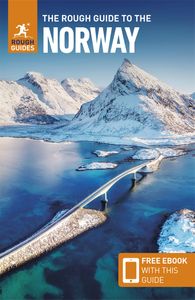Vikingskipshuset
The Vikingskipshuset (Viking Ships Museum) occupies a large, cross-shaped hall specially constructed to house a trio of ninth-century Viking ships, with viewing platforms to enable you to see inside the hulls. The museum’s star exhibits are the Oseberg and Gokstad ships, named after the places on the west side of the Oslofjord where they were discovered in 1904 and 1880 respectively.
All three oak vessels were retrieved from ritual burial mounds in southern Norway, each embalmed in a subsoil of clay, which accounts for their excellent state of preservation. The size of a Viking burial mound denoted the dead person’s rank and wealth, while the possessions buried with the body were designed to make the afterlife as comfortable as possible. Implicit was the assumption that a chieftain in this world would be a chieftain in the next, a belief that would subsequently give Christianity, with its alternative, less fatalistic vision, an immediate appeal to those at the bottom of the Viking pile – slaves, for example, were frequently killed and buried with their master or mistress. Quite how the Vikings saw the transfer to the afterlife taking place is less certain. The evidence is contradictory: sometimes the Vikings stuck the anchor on board the burial ship in preparation for the spiritual journey, but at other times the vessels were moored to large stones before burial. Neither was ship burial the only type of Viking funeral – far from it. The Vikings buried their dead in mounds and on level ground, with and without grave goods, in large and small coffins, both with and without boats – and they practised cremation too.
Oseberg ship
The first vessel you see as you enter the museum is the Oseberg ship, which is, at 22m long and 5m wide, representative of the type of vessel the Vikings used to navigate fjords and coastal waters. The ship has an ornately carved prow and stern, both of which rise high above the hull, where thirty oar-holes indicate the size of the crew. It is thought to be the burial ship of a Viking chieftain’s wife and much of the treasure buried with it was retrieved and is now displayed just behind it. The grave goods reveal an attention to detail and a level of domestic sophistication not traditionally associated with the Vikings. There are marvellous decorative items like the fierce-looking animal-head posts and exuberantly carved ceremonial pieces, including a sled and a cart, plus a host of smaller, more mundane household items such as shoes, rattles, agricultural tools and cooking pots.
The Gokstad and Tune ships
Mixed in among the treasure from the Oseberg ship are finds from the Gokstad ship, most memorably an ornate bridle and two dragon-head bedposts, though the Gokstad burial chamber was ransacked by grave robbers long ago and precious little has survived. The Gokstad ship itself is slightly longer and wider than the Oseberg vessel and is quite a bit sturdier too. Its seaworthiness was demonstrated in 1893 when a replica sailed across the Atlantic to the USA. The third vessel, the Tune ship, is the smallest of the nautical trio and only fragments survive; these are displayed unrestored, much as they were discovered in 1867 on the eastern side of the Oslofjord.
Anne Stine and Helge Ingstad – or how the Norse beat Christopher Columbus
Often unnoticed, a modest monument beside the entrance to the Vikingskipshuset honours Helge Marcus Ingstad (1899–2001) and his wife Anne Stine (1918–1997), explorer-archeologists who spent years looking for Norse settlements on the North Atlantic seaboard. Their efforts were inspired by two medieval Icelandic sagas, which detailed the establishment of the colony of Vinland somewhere along the American coast in about 1000 AD. Many academics were sceptical, but Ingstad and Stine were proved right when, in 1960, they discovered the remnants of a Norse village at L’Anse aux Meadows in Canada’s Newfoundland. These remains comprised the foundations of eight turf and timber buildings and a ragbag of archeological finds, including a cloak pin, a stone anvil, nails, pieces of bog iron and an oil lamp. Ingstad and Stine concluded that these were left behind by a group of about one hundred sailors, carpenters and blacksmiths who probably remained at the site for just one or maybe two years – and several hundred years before Columbus reached the Americas.



















